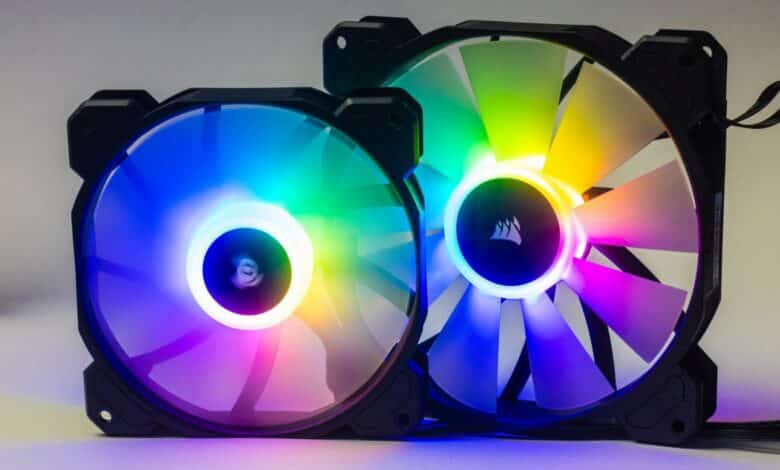
Corsair can be found in almost every area of PC hardware. It is therefore not surprising that there is also a large selection of fans, most of which are in the mid to upper price range. The RGB version of the Corsair SP Elite can be found in the mid-price range. And this is exactly what we take a closer look at in the Corsair SP RGB Elite fan test!
Specifications
120 mm
| Size | 120 x 120 x 25 mm |
| Speed | 400 – 1500 RPM |
| LEDs | 8x RGB |
| Static pressure | 1.46 mm H2O |
| Air flow | 81.04 m³/h |
| Price | € 21.99 * (single) € 52.90 * (3-pack) |
140 mm
| Size | 140 x 140 x 25 mm |
| Speed | 450 – 1200 RPM |
| LEDs | 8x RGB |
| Static pressure | 1.66 mm H2O |
| Air flow | 115.7 m³/h |
| Price | € 27.06 * (single) € 43.00 * (2-pack) |
Packaging and scope of delivery
- Characteristic Corsair signal color bundle
- Slot provides additional protection for the fan
- Fan screws and instructions are included in the scope of delivery
Corsair’s packaging design is almost always characteristically eye-catching. The high-contrast design with the black side and the otherwise signal yellow packaging quickly catches the eye. The front is kept quite clean with a product imprint and the article name. On the back is a multilingual summary of the most important features and the list of specifications. If you open the box – you have to be a little careful not to tear it – you will find a robust insert. This provides additional protection for the fan during transportation. The front is only covered with the instructions. If you pull out the slide-in unit, you can see the fan. The cables and screws can then be found under another cover, which keeps the view clean.
Apart from the fan screws and the manual, there are no accessories included with the Corsair iCue SP RGB Elite fans.
Design
- Black frame with milky white fan blades
- Powerful lighting
- Labeling on the back is somewhat visually distracting
At first glance, the Corsair iCue SP RGB Elite fans appear to be fairly simple RGB fans with illuminated fan blades and a black frame. The 120 mm version comes with seven fan blades and the 140 mm version with nine. The frame is textured matt black and roughly follows an 8-corner shape, with the corners protruding from the frame like ears. The Corsair logo in the middle naturally rotates with it. On the back are the usual details, which form a high contrast and are therefore quite noticeable depending on the viewing direction and lighting in the case.
The fan motor is not only connected to the frame via four bars, but a large number of struts, which also control the air direction with their shape, ensure a good distribution of the load capacity. The cables run quite inconspicuously to the outside via one of the struts.
The Corsair SP RGB Elite fans are illuminated from the center. Eight LEDs provide the light, while the milky-white fan blades ensure relatively even light diffusion.
Processing
- Inconspicuous build quality
- Relatively wide distance between the fan blades and the frame
- Thin, long cables are easy to lay, but excess lengths are sometimes difficult to tie out of the way.
The workmanship of the Corsair SP RGB Elite fans proved to be unspectacular but neat in the test. The frame is made of black plastic and has no rubberized corners. The material looks rather cheap and does not quite match the “mid-range price”. The distance between the fan blades and the frame is also slightly larger than with many modern fans. Overall, the shape indicates a pressure-optimized design. This means that the individual fan blades are quite wide, have little space between them and are rather flat.
The LEDs are bright, but are only located around the fan motor in the middle. At least they are positioned in such a way that individual LEDs do not stand out from any position, but there is a fairly clean, uniform light pattern.
Each of the fans has two cables – a regular fan cable with PWM connector and an RGB cable with a proprietary iCue connector from Corsair. The cables are thin and unsheathed. This makes them easy to lay and inconspicuous. However, this may make them a little more sensitive when it comes to sharp edges. The cables are also quite long, around half a meter. On the one hand, this is sufficient for laying them in large enclosures, but on the other hand you have to somehow keep excess lengths under control and stow them away somewhere, which makes cable management more difficult. I have to admit that I prefer concepts here that use shorter cables and the extension cables supplied.
Control
- A suitable Corsair RGB controller is required
- The software control runs via Corsair iCue
The Corsair iCue SP Elite RGB fans are controlled via a 4-pin PWM fan connector. However, the RGB lighting must be controlled via Corsair iCue. A suitable controller is required for this if you are not using a Corsair case with an integrated controller.
Accordingly, the appropriate “Corsair iCue” software is also required. The current version of this can be found in the downloads on the official Corsair website. This proprietary system has the disadvantage that Corsair fans cannot be mixed with fans from other brands. However, you can of course combine different Corsair fans. Apart from that, there is also the advantage that Corsair iCue runs relatively reliably and there are no problems with unknown hardware.
In Corsair iCue you can take over the complete control of the fans. Depending on the controller and its capabilities. The Commander Core XT (€ 57.87 *) was used in the test. Here, for example, the RGB functions can be controlled, as well as the fan speed and the orientation of the fans.
Performance as a case fan
- Low suitability as a case fan
- Most other fans are more efficient here
The Corsair iCue SP RGB Elite fans are less suitable as case fans. In terms of design, the static pressure is quite powerful, but it simply moves relatively little air. In a performance measurement with other fans at a uniform speed, this leads to a mediocre performance at a slightly higher volume. If you normalize the volume, you have to let the fans rotate so slowly that most of the other fans pass by in terms of performance.
If the volume doesn’t matter and you let the fans run freely, the performance suffers from the low maximum speed. But at least the fans themselves don’t get that loud.
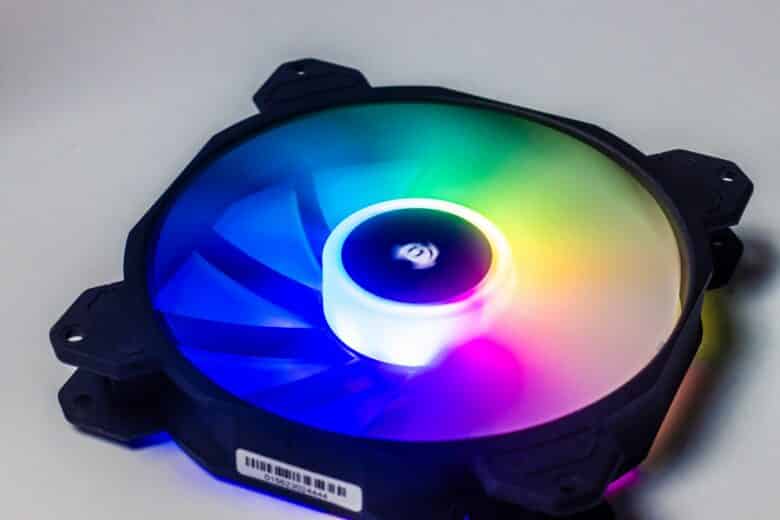
The Corsair SP RGB Elite test shows that these fans should not be purchased for use as case fans
Performance on the radiator
- Very good performance on the radiator
- High static pressure is optimal for use with high resistance
The situation is completely different on radiators. This is where the Corsair iCue SP RGB Elite comes into its own. The static pressure and performance are similar to the Noctua NF-P redux. Where these fans do not quite reach the performance peak, the performance is still strong and the temperature is dissipated well from radiators.
Even at peak performance, the mediocre top speed is not as noticeable as you would expect. Some high-performance fans pass by, but also become noticeably louder.
At a uniformly low volume, the Corsair iCue SP140 RGB Elite pulls up to the performance level of the Thermaltake TOUGHFAN 14 RGB. The Corsair iCue SP120 RGB Elite just beats the Lian Li Uni Fan AL120 V2 on the radiator and is roughly at the same performance level as the Noctua NF-F12.
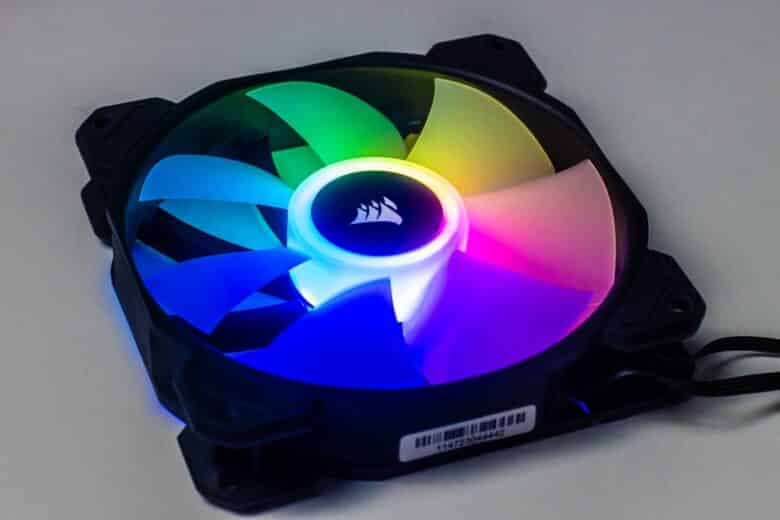
In short, the Corsair iCue SP RGB Elite fans are a very good choice for radiators if you’re looking for RGB fans. But the Corsair iCue AF RGB Elite – especially in the 140 mm version – are still slightly better performing.
Corsair iCue SP120 RGB on the air cooler
- Acceptable but inconspicuous performance on the air cooler
- Outside of the Corsair system, you can find cheaper fans for this purpose
I’ll be brief here: The Corsair iCue SP120 RGB Elite test shows a fairly mediocre performance on the air cooler. This can also be seen in the large air cooler fan test (120 mm). This means that it is certainly suitable as a fan on a 120 mm air cooler, but that there are also better fans for this application. And some of them are also cheaper.
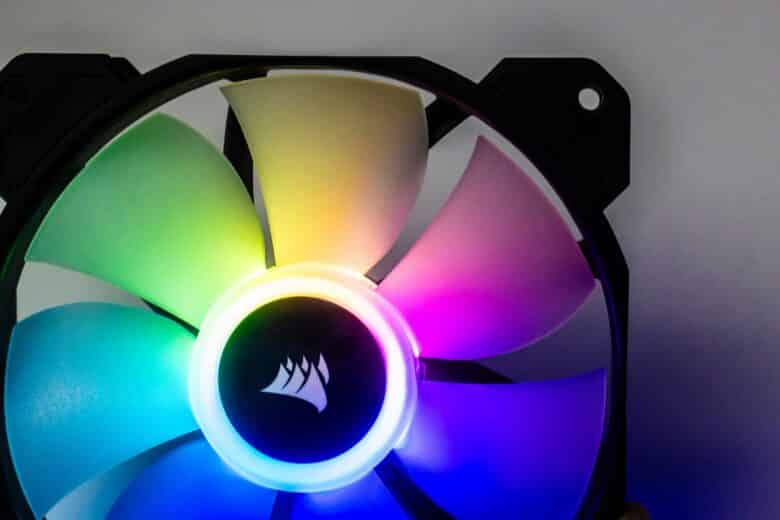
In this area, however, the difference to the Corsair iCue AF120 RGB Elite is not quite so huge. The AF120 RGB is still preferable because it is a little quieter and, in particular, has a higher maximum speed, which increases the maximum performance.
Conclusion
Overall, the Corsair iCue SP RGB Elite fans in the test are unspectacular, but in terms of performance quite good fans when used on the radiator. The build quality is not outstanding; many noticeably cheaper fans look at least as solid. But in the Corsair universe, these fans are still among the most affordable options and the radiator performance puts these pressure-optimized fans in a good light. As do the bright RGB LEDs with their beautiful color display.
Would I recommend these fans? Hard to say. You can find more performance for the money, but overall these fans are fine, especially if you want to expand your Corsair system and are looking for radiator fans. However, if you don’t have a very tight budget – and in this case I would recommend cheaper fans anyway – you should also take a look at the more powerful, quieter and better-finished Corsair iCue AF RGB Elite fans. These can also be used more universally.
Corsair SP RGB Elite
Workmanship
Noise level
Performance
Features
Value for money
75/100
The Corsair iCue SP RGB Elite fans are basically quite simple RGB fans with proprietary RGB control and acceptable performance.

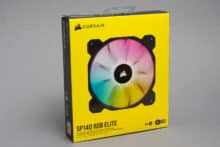
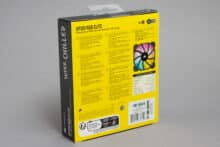
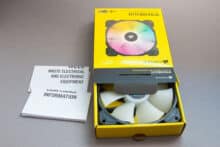
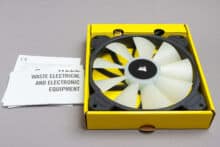
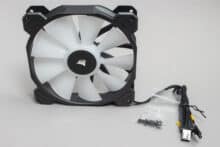
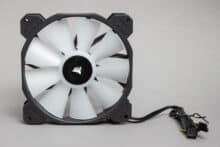
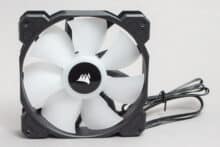

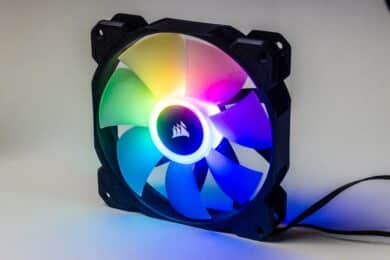

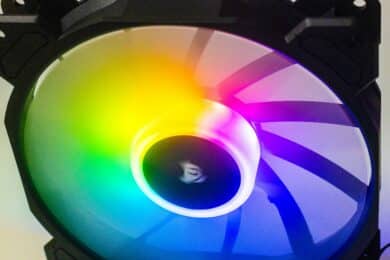

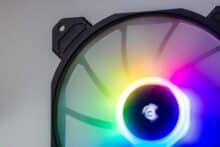
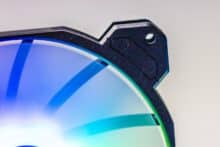
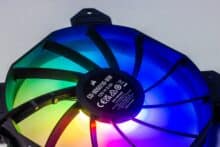
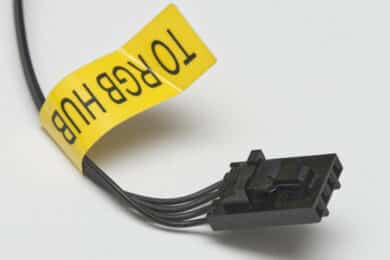
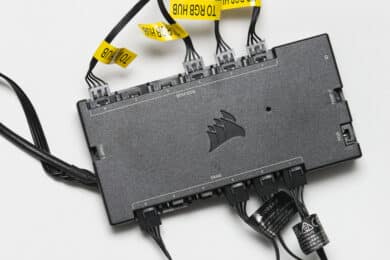
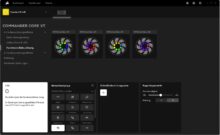

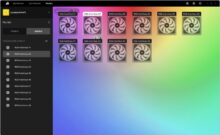
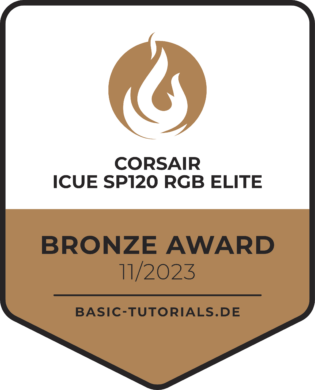
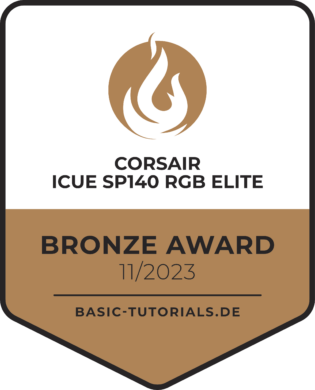

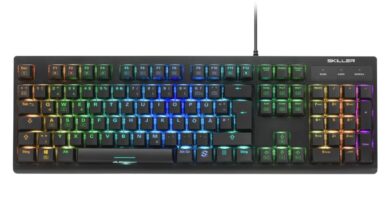
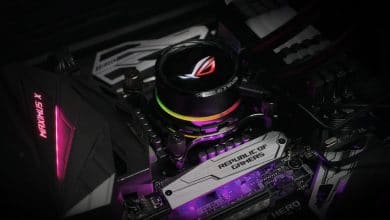
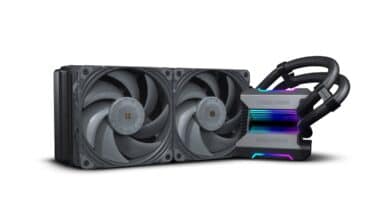
No replies yet
Neue Antworten laden...
Gehört zum Inventar
Beteilige dich an der Diskussion in der Basic Tutorials Community →